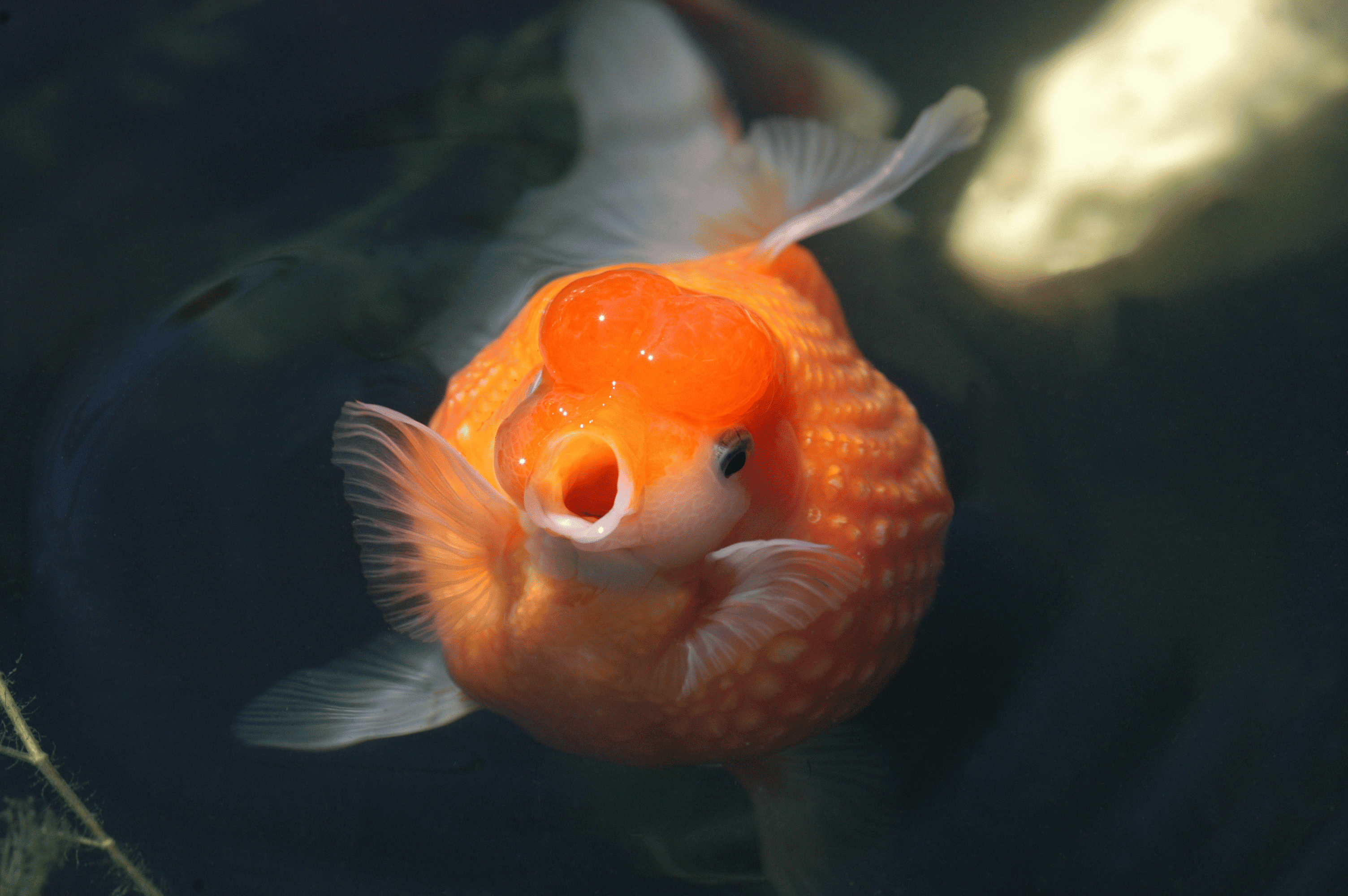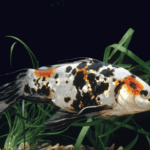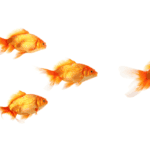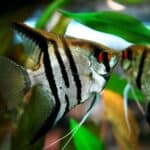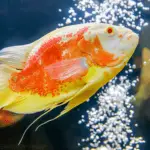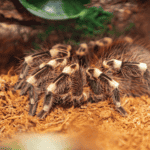Goldfish enthusiasts and aquarium hobbyists may come across a fascinating member of the species known as the fat goldfish or fat head goldfish. These unique freshwater creatures, specifically bred for their captivating appearance, make a striking addition to aquariums and offer a different experience from the standard goldfish. It’s essential to understand how to properly care for and manage these intriguing members of the Asian carp family, as they require specific attention to their needs and environment.
The fat head goldfish is a fancy goldfish species that has been selectively bred for its unique features, including a prominent “wen,” or headgrowth, similar to that of a lion’s mane. As a type of egg-shaped goldfish, they share some similarities with other fancy goldfish breeds such as the oranda, ranchu, and ryukin. However, unlike some of their counterparts, fatheads do not have a dorsal fin, setting them apart both visually and in terms of mobility.
In addition to their extraordinary appearance, fat goldfish can also exhibit health conditions like dropsy, characterized by bloating and fluid buildup. It’s crucial for owners to monitor their goldfish for any signs of illness and to maintain proper water conditions and nutrition to prevent and treat issues. Understanding these challenges and providing the necessary care will ensure that your fat goldfish remains healthy and content while showcasing its unique beauty in your aquarium.
Fat Goldfish Overview
Identification
Fat goldfish can be identified by their significantly round and plump body shape, as compared to the more elongated shape of the common goldfish. Many of these goldfish are considered fancy goldfish breeds, such as the Pearlscale, Lionhead, and Oranda. They come in various colors, including red, orange, calico, yellow, brown, white, and black.
Natural Habitat
While fat goldfish, like many fancy goldfish species, are not found in the wild, they belong to the Asian carp family. The goldfish we know today have been selectively bred over centuries from the wild Prussian carp. Goldfish can adapt to a wide range of habitats, temperatures, and oxygen levels, making them hardy and resilient fish.
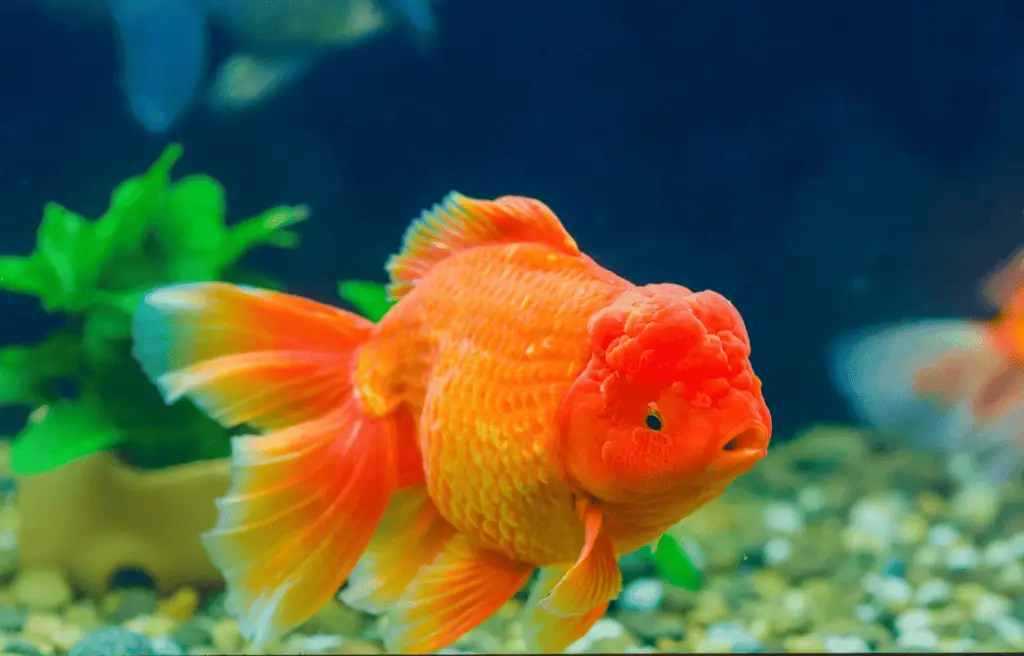
Varieties
Here are some examples of Fat Goldfish varieties:
- Pearlscale: Known for its distinctive round, plump body resembling an orange, the Pearlscale can have a wen (a fleshy growth covering parts of the head) or a bubble called a crown. Some even have a double bubble crown.
- Lionhead: Also known as the fat head goldfish, the Lionhead is a quirky-looking fish with a short, round body and a wen-like growth on its head, giving it a lion-like appearance.
- Oranda: The Oranda goldfish is similar in appearance to the Lionhead, with a round body and a wen on its head. However, the Oranda also sports a double tail, akin to the Fantail goldfish. This tail is often shorter and more rounded compared to other fancy goldfish varieties.
- Ryukin: Notably round-bodied and humpbacked, the Ryukin’s distinctive feature is its sharply curved back and rounded belly. They are available in many color variations, including calico, red, orange, and white.
- Ranchu: Closely related to the Lionhead, the Ranchu is commonly referred to as the king of goldfish in Japan. Its round appearance and lack of a dorsal fin make it a popular choice among fancy goldfish enthusiasts.
Each of these fat goldfish varieties exhibit unique characteristics and appearances but share a common trait: their round, plump bodies.
Goldfish Body Shape and Types
Goldfish come in a variety of shapes and sizes, with body types generally classified into two main categories: streamlined and egg-shaped. Streamlined goldfish tend to have slimmer, more elongated bodies suited for agile swimming, while egg-shaped goldfish are characterized by their rounder, more compact bodies. These body shapes directly influence the types and varieties of goldfish found within the single tail and double tail categories.
Single Tail Goldfish Varieties
Single tail goldfish are typically streamlined in body shape, making them fast swimmers with fewer decorative features. Common types of single tail goldfish include:
- Comet: Known for their long, flowy tail and slender body, comets are a popular and hardy goldfish variety.
- Common Goldfish: As the name suggests, common goldfish are the most recognizable, with a short, flat body and a straight, unbranched tail.
- Shubunkin: Often referred to as “calico goldfish” due to their colorful scales, shubunkins have a more rounded body and a single, flowing tail.
- Wakin: Closely related to the common goldfish, wakins have a more rounded body shape and slightly more elaborate single tail.
Egg-Shaped and Double Tail Goldfish Varieties
Egg-shaped goldfish, also known as fancy goldfish, are best known for their unique appearances and double tails. These round-bodied fish typically have shorter, more compact bodies compared to their streamlined counterparts. Some examples of egg-shaped goldfish varieties are:
- Fantail: Noted for their beautiful double tail and egg-shaped body, fantails are a popular choice for goldfish enthusiasts.
- Ryukin: Characterized by a distinct hump near their dorsal fin, ryukins have a broad, round body and double tail.
- Veiltail: With their long, delicate tails that resemble a flowing veil, veiltails are known for their slow, graceful swimming.
- Oranda: Possessing a wart-like growth called a wen on their heads, orandas are a distinctive variety with a double tail and round body.
- Telescope: Named for their protruding eyes, telescope goldfish have a round body and double tail, making them a unique and interesting variety.
Remember to always consider the specific needs and characteristics of each goldfish variety before adding them to an aquarium, as their body shapes can impact their swimming abilities, dietary requirements, and compatibility with other fish.
Goldfish Anatomy
Fins and Dorsal Fin
Goldfish have several types of fins that help them navigate and maintain balance in the water:
- Pectoral fins are located on each side of the fish and help with steering and maintaining stability.
- Ventral fins are found on the bottom of the fish and also assist in balancing.
- The caudal fin is the tail fin and is responsible for propulsion.
- The anal fin is located between the ventral fins and the caudal fin, playing a role in stabilization.
The dorsal fin, found on the top of the goldfish, is another important fin for stability. It helps the fish maintain its upright position and prevents it from rolling or tipping over.
Eyes
Goldfish have well-developed eyes that allow them to recognize patterns, faces, and colors. In fact, they can see more colors than humans can. While goldfish cannot see in complete darkness, they are able to detect movement and shapes in low-light environments.
Shape and Coloring
The shape of a goldfish’s body varies depending on the specific breed. Common goldfish have a streamlined and elongated body shape, while fancy goldfish breeds may display a rounder or egg-shaped body. Bulging eyes are a distinctive feature present in some fancy goldfish varieties, such as the Black Moor and Celestial Eye.
Goldfish come in various colors, including:
- Orange
- Red
- White
- Black
- Yellow
- Blue
- Brown
The coloration of a goldfish is determined by its pigment cells (chromatophores) and the arrangement of its scales. Patterning and color intensity may change as the fish grows and can also be affected by environmental factors such as diet, water quality, and exposure to sunlight.
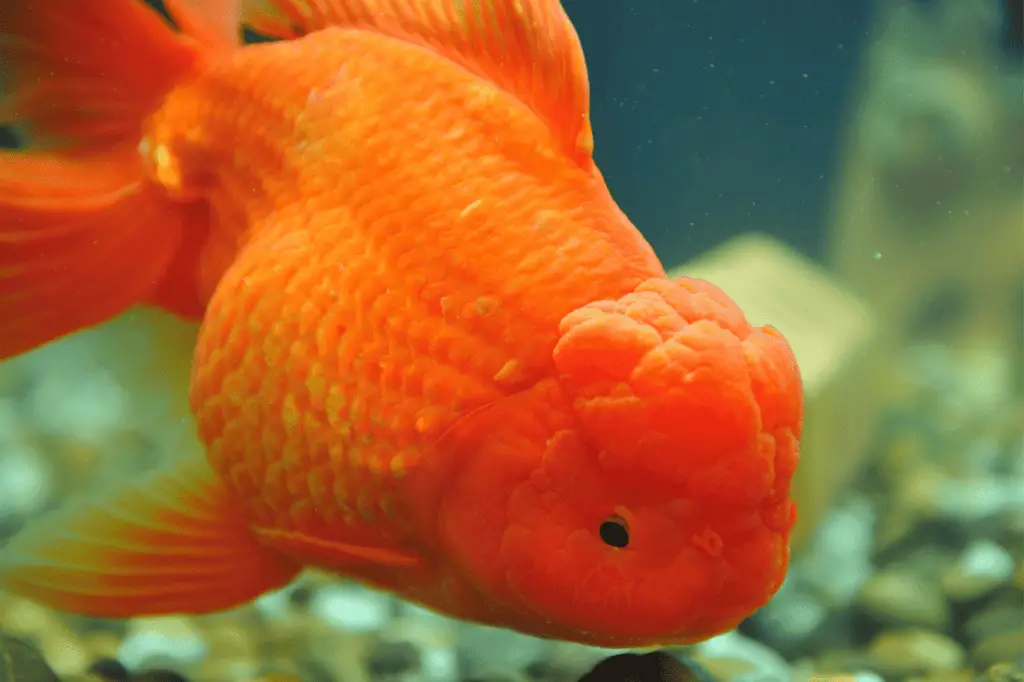
Goldfish Health Issues
Swim Bladder Disease
Swim Bladder Disease is a common health issue in goldfish, which affects their buoyancy. Goldfish have a unique anatomy with a duct connecting their esophagus and swim bladder. They swallow air to inflate and rise in the water. Swim bladder problems can result in the fish having trouble maintaining their position in the water, either floating or sinking more than usual. Stress can exacerbate these issues, and treating the underlying cause is essential.
Constipation and Bloating
Constipation is another common health issue in goldfish, leading to bloating. Overfeeding, poor-quality food, and lack of fiber in their diet can result in constipation. Signs of this issue may include a swollen abdomen and difficulty swimming. To prevent and treat constipation:
- Feed your goldfish high-quality, nutrient-rich food.
- Include fiber-rich vegetables in their diet.
- Do not overfeed them.
- Consider using live or frozen food as a source of nutrients and probiotics.
Dropsy and Kidney Function
Dropsy is a condition characterized by a swollen or “fat” appearance in goldfish, often due to kidney dysfunction. The kidneys help to remove waste and excess fluids, but when they fail, fluids accumulate in the fish’s body, causing swelling. Treatment for dropsy typically involves:
- Isolating the affected goldfish in a quarantine tank.
- Maintaining the quarantine tank temperature around 25ºC / 77ºF.
- Using anti-bacterial medication as directed.
- Adding aquarium salt to improve fish’s overall health.
Infectious Diseases
Goldfish are susceptible to various infectious diseases, such as fin rot, velvet, and ulcers. These infections can be caused by bacteria, fungi, or viruses, and a goldfish’s appearance or behavior may change when they are affected. Treating these diseases often involves:
- Identifying the specific infection.
- Implementing proper quarantine procedures.
- Using appropriate medications or treatments.
- Maintaining a clean, stress-free environment.
Parasitic Infestations
Parasitic infestations, such as white spot, anchor worms, fish lice, and chilodonella, are common in goldfish, leading to irritation, discomfort, and even disease. Preventing and treating these infestations entails:
- Implementing a strict quarantine protocol for new fish.
- Using appropriate treatments or medications.
- Keeping the environment clean and well-maintained.
- Observing your goldfish for any signs of parasites, infection, or changes in behavior.
Goldfish Breeding
Breeding Process
Goldfish breeding typically occurs during spring when the temperature gradually increases. To replicate this process in a controlled environment, lower your tank’s temperature to between 10°C/50°F and 12°C/54°F. Next, incrementally raise the water temperature by 2°C/3°F per day until it reaches between 20°C/68°F and 23°C/74°F. This temperature change will encourage goldfish to mate and lay eggs within the breeding tank.
During the mating process, a healthy female goldfish will release eggs that adhere to aquatic plants or a spawning mop placed in the tank for this purpose. The male goldfish will then swim near the eggs, fertilizing them as his milt spreads throughout the water. Once the eggs are fertilized, remove the parent goldfish to prevent them from eating the eggs or the resulting fry.
Selective Breeding
Selective breeding is a process used to create specific desirable traits in goldfish offspring. In this practice, goldfish with preferred characteristics are selected and bred together, producing offspring with a higher chance of displaying those desired traits. Over time and through multiple generations, the preferred characteristics become more pronounced. Selective breeding has resulted in a wide variety of goldfish types, differing in size, color, body shape, and fin configuration.
Goldfish Types
Various goldfish types have emerged through selective breeding. Some examples include:
- Common Goldfish: These goldfish closely resemble their wild counterparts and are characterized by their hardy nature and streamlined bodies.
- Comet Goldfish: Similar to the common goldfish but with longer fins, comet goldfish are known for their graceful swimming patterns and quick movements.
- Fancy Goldfish: This category includes numerous varieties such as Oranda, Ryukin, Bubble Eye, Pearlscale, and more. Fancy goldfish are known for their unique physical traits, such as egg-shaped bodies, elaborate fins, and distinctive head growths.
The diversity of goldfish types showcases the potential of selective breeding in creating fascinating and distinct goldfish varieties.
Famous Goldfish Varieties
Comet Goldfish
Comet goldfish are a popular variety known for their elongated bodies and single tails. They come in various colors, including orange, red, and white. Comet goldfish are active swimmers and do well in ponds as well as aquariums.
Fantail Goldfish
Fantail goldfish have a round body shape and double tails that develop as they mature. Their tails fan out, giving them the ‘fantail’ name. They come in a variety of colors and are suitable for aquariums due to their slower swimming pace.
Ryukin Goldfish
The Ryukin goldfish, also known as the Japanese fantail, have a short and deep body with a pointed head. This variety features a hump in the shoulder region and can have long or short fins, all with a double tail. Ryukin goldfish are adaptable to both ponds and aquariums.
Pearlscale Goldfish
Pearlscale goldfish are distinguished by their round, “pearl”-covered bodies. They have a compact, round body shape and their scales have a unique, raised texture. Pearlscales usually have double tails and are well-suited for aquariums.
Lionhead Goldfish
Lionhead goldfish are characterized by their distinct head growth that resembles a lion’s mane. They have a short, round body shape and typically lack a dorsal fin. Lionheads come in various colors and patterns and are popular within the fancy goldfish community.
Oranda Goldfish
Oranda goldfish are known for their “wen” growth on top of their heads, which can resemble a raspberry. They have a round body shape, double tails, and a dorsal fin. Orandas come in a variety of colors, with the red cap oranda being a popular variation.
Telescope Goldfish
Telescope goldfish are named for their protruding, telescope-like eyes. They have a rounded body shape, double tails, and can come in a variety of colors and patterns. This variety requires more care and attention due to their delicate eyes.
Celestial Goldfish
Celestial goldfish possess unique, upward-facing eyes, giving them their name. They have a slim, elongated body and double tails. This distinctive variety requires careful maintenance as their eyes make it difficult to see.
Shubunkin Goldfish
Shubunkin goldfish are known for their vibrant, calico patterns consisting of red, white, black, and blue colors. They have an elongated body shape, similar to the Comet goldfish, and single tails. Shubunkins are hardy fish and suitable for ponds and aquariums.
Veiltail Goldfish
Veiltail goldfish are characterized by their long, flowing double tails that resemble a veil. They have a round body shape and can come in various colors, with red and white being the most common. This variety is well-suited for aquariums and requires gentle water conditions.
Black Moor Goldfish
Black Moor goldfish are notable for their velvety black color and large, protruding eyes similar to the Telescope goldfish. They have a rounded body shape, double tails, and adapt well to aquariums.
Ranchu Goldfish
Ranchu goldfish, a popular variety in Japan, are known for their rounded bodies, short tails, and lack of a dorsal fin. They have a unique head growth similar to Lionhead goldfish. Ranchus come in various colors and do well in aquariums.
Carassius Auratus
Carassius auratus is the scientific name for the common goldfish. They are the direct ancestor of all goldfish varieties and come in various colors, including red, orange, blueish-grey, brown, yellow, white, and black. Carassius auratus are suitable for both ponds and aquariums.
Goldfish Origins and History
The goldfish we know today, Carassius auratus, were domesticated in ancient China from crucian carp. Crucian carp is one of the most important farmed fish globally, with its aquaculture production reaching 3.096 million tons in 2018. The appearance of red scales on normally gray or silver crucian carp was first recorded during the Chinese Jin Dynasty (AD 265-420).
In ancient China, during the Sung Dynasty (960-1279), domestic goldfish breeding started. The imperial family saw goldfish as a symbol of wealth and began intentionally breeding these fish in yellow to coincide with their color-themed rule. Only the imperial family could raise and keep yellow goldfish.
By the 1500s, goldfish had made their way outside of China, moving to Japan, where they became a beloved national treasure. The first known English drawing of a goldfish was made in 1711 by English botanist James Petiver. By the 1800s, goldfish had made their way to other parts of the world.
To summarize, the origins of goldfish can be traced back to ancient China, where they were first domesticated from crucian carp. Over time, goldfish spread throughout the world, becoming a popular ornamental fish and symbol of wealth in various cultures.
Goldfish Myths and Facts
There are several myths and misconceptions surrounding goldfish that can sometimes mislead the public. In this section, we will address some of these myths, provide factual information, and cover their lifespan, behavior, temperament, and survival.
Myth: Goldfish can be kept in bowls.
- Fact: Goldfish should be kept in properly sized tanks with adequate filtration and aeration. Bowls are not suitable homes for goldfish, as they provide poor water quality and can stunt their growth.
Myth: Goldfish only grow to the size of their enclosure.
- Fact: Goldfish can grow quite large, regardless of their enclosure size. However, living in a small environment can lead to stress and health issues, which is why it’s essential to provide them with enough space.
Myth: Goldfish have a three-second memory.
- Fact: Studies have shown that goldfish actually have a relatively good memory, capable of remembering spatial information and being trained to perform tasks.
Goldfish typically have a lifespan of around 10-15 years in the right conditions, although some can live even longer if well-cared for.
In terms of behavior, goldfish are social creatures and are known to be more active and healthy when kept in small groups. They are also intelligent and can recognize their owners, as well as learn simple tricks and routines.
When it comes to temperament, goldfish are generally peaceful and can coexist with other non-aggressive fish species. However, they might exhibit territorial behavior or nip at tank mates who appear similar to them, such as other goldfish varieties.
Survival is an important aspect of goldfish care. Providing a suitable environment with clean water, regular maintenance, and a proper diet can significantly improve a goldfish’s chances of living a long and healthy life. Additionally, monitor water parameters and ensure that goldfish are compatible with their tank mates to avoid stressful situations that might compromise their health.
